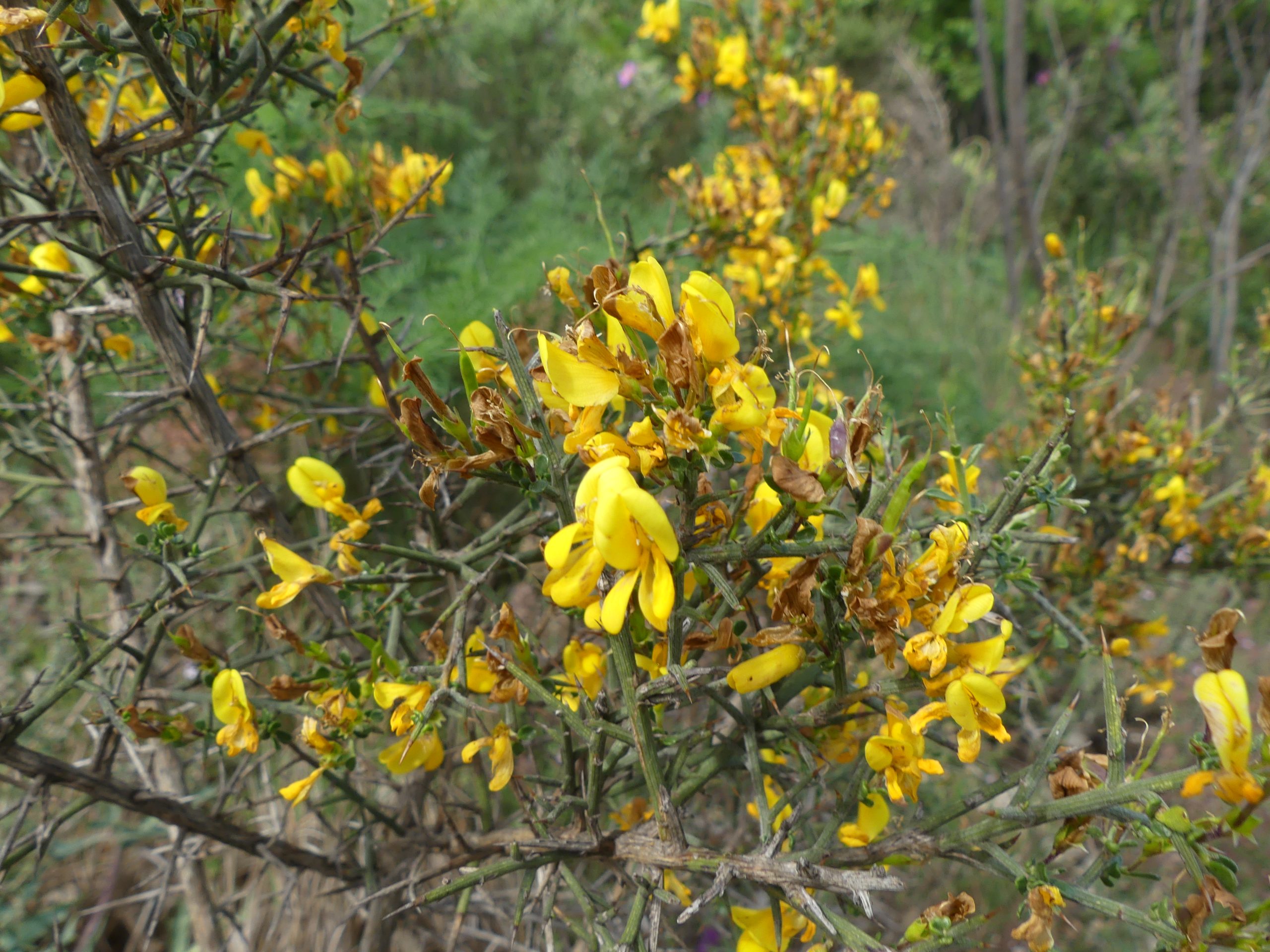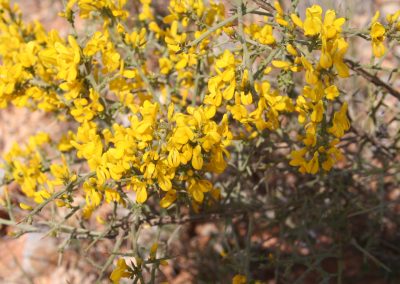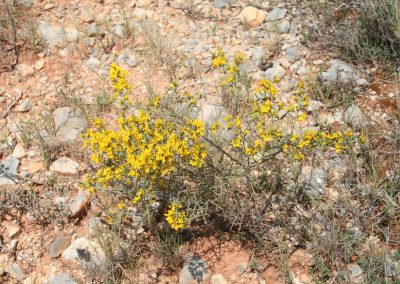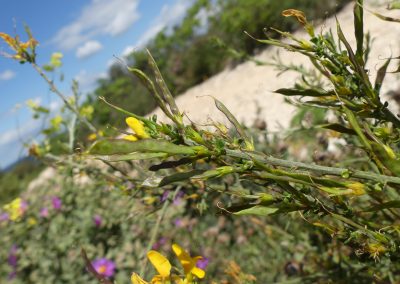Genista scorpius
Scientific description
Taxon: Genista scorpius
Class: Dicotyledons (Magnoliopsida)
Subclass: Rosids
Order: Fabales
Family: Fabaceae
Common name: Scorpion broom
Origin:
Southwestern Europe, Mediterranean region.
Description:
Spiny, dense shrub, 1–2 m high. Twisted branches with short curved spines. Leaves small, trifoliate, often deciduous. Flowers in spring, bright yellow in dense clusters typical of Fabaceae. Hardy, adapted to poor, dry, rocky soils; compact, spiny form protects from grazing.
Propagation:
By seeds (better after fire or scarification). Cuttings possible but less common.
Ecology:
Pioneer plant, stabilizes soils, fixes nitrogen via Rhizobium symbiosis. Adapted to dry Mediterranean climates and frequent fires.
Uses:
Reforestation, erosion control, ornamental in dry gardens. Rare traditional medicinal use.
Threats:
No major known threats; common in its natural range.
Taxon : Genista scorpius
Classe : Dicotylédones (Magnoliopsidées)
Sous-classe : Rosidées
Ordre : Fabales
Famille : Fabacées
Nom commun : Genêt scorpion
Origine :
Sud-ouest de l’Europe, région méditerranéenne.
Description :
Arbuste épineux, dense, 1–2 m. Rameaux tortueux avec épines courtes et recourbées. Feuilles petites, trifoliolées, souvent caduques. Floraison au printemps, fleurs jaunes vives en grappes denses. Rustique, adapté aux sols pauvres, secs et rocailleux; forme compacte protège du pâturage.
Propagation :
Graines (mieux après feu ou scarification). Bouturage possible mais moins courant.
Écologie :
Plante pionnière, stabilise les sols, favorise la fixation de l’azote via symbiose avec Rhizobium. Adaptée aux climats méditerranéens secs et incendies fréquents.
Utilisation :
Reboisement, lutte contre l’érosion, ornement dans jardins secs. Usage médicinal rare.
Menace :
Pas de menace majeure connue; espèce commune dans son aire naturelle.
Taxon: Genista scorpius
Clasă: Dicotiledonate (Magnoliopsida)
Subclasă: Roside
Ordin: Fabales
Familie: Fabaceae
Denumire populară: Genist scorpion
Origine:
Sud-vestul Europei, regiunea mediteraneană.
Descriere:
Arbust spinos, dens, 1–2 m. Ramuri răsucite cu spini scurți, curbați. Frunze mici, trifoliate, adesea caduce. Flori primăvara, galbene strălucitoare, ciorchini densi. Adaptat soluri sărace, uscate, stâncoase; forma compactă protejează de pășunat.
Propagare:
Semințe (mai bune după foc sau scarificare). Butași posibili, mai puțin frecvent.
Ecologie:
Plantă pionieră, stabilizează solurile, fixează azot prin simbioza cu Rhizobium. Adaptată la clima mediteraneană uscată și incendii frecvente.
Utilizare:
Reîmpăduriri, combaterea eroziunii, ornamental în grădini uscate. Folosință medicinală rară.
Amenințări:
Fără amenințări majore; specie comună în arealul său natural.
Ταξινόμηση: Genista scorpius
Κλάση: Δικοτυλήδονα (Magnoliopsida)
Υποκλάση: Ροσίδες
Τάξη: Fabales
Οικογένεια: Fabaceae
Κοινό όνομα: Σκορπιόχορτο
Προέλευση:
Νοτιοδυτική Ευρώπη, Μεσογειακή περιοχή.
Περιγραφή:
Αγκαθωτός, πυκνός θάμνος 1–2 μ. Κλαδιά στριφτά με κοντά, κυρτά αγκάθια. Φύλλα μικρά, τριφυλλά, συχνά φυλλοβόλα. Άνθη άνοιξη, λαμπερά κίτρινα σε πυκνούς ταξιανθίες. Σκληραγωγημένο, προσαρμοσμένο σε φτωχά, ξηρά, βραχώδη εδάφη· συμπαγής μορφή προστατεύει από βόσκηση.
Διάδοση:
Σπόροι (καλύτερη βλάστηση μετά φωτιά ή γρατζουνιά). Καταβολάδες δυνατές αλλά λιγότερο συχνές.
Οικολογία:
Είδος πρωτοπόρο, σταθεροποιεί τα εδάφη, δεσμεύει άζωτο μέσω Rhizobium. Προσαρμοσμένο σε ξηρά μεσογειακά κλίματα και πυρκαγιές.
Χρήσεις:
Αναδασώσεις, καταπολέμηση διάβρωσης, καλλωπιστικό σε ξηρούς κήπους. Σπάνια παραδοσιακή ιατρική.
Απειλές:
Δεν υπάρχουν σοβαρές γνωστές απειλές, κοινό είδος στο φυσικό του εύρος.
Creative writing inspired by Genista scorpius
The secret of Zehir
In a remote valley in northern Morocco called Mnoud, all the plants lived in harmony, but among them was a magnificent plant named Zehir. His beauty, smile, intelligence and kindness made him a role model for all. But behind these facets lay a manipulator and a liar.
Zehir would never help those closest to him without a reason. Every gesture, every word was calculated to obtain what he wanted: the trust and control of the people. When a plant asked for his help, he saw to it that it became dependent on him for acclaim. When conflict broke out, he would mediate, trying to calm tensions, but secretly fueling them to better profit from them. He only befriended influential plants that could be of use to him.
One day, a brand new conflict broke out in Mnoud between two families over a vegetable garden. Zehir pretended to help them, but instead advised both families to beware of the other. He sowed even more zizanie between them like a scorpion discreetly spitting its poison on its victims, but no one suspected a thing. The conflict only escalated, and when it reached its peak, the families lost everything, even their petals. It was at this point that Zehir pretended to be concerned and to want to help each of his families, even though he was, without anyone knowing it, the one who had caused so much trouble. As he had foreseen, these events gave him greater power and influence with the others.
In the vegetable garden, he continued to be seen as a hero. But Zehir, alone in front of his mirror, knew he was just a manipulator. And he was proud of it, calling himself “the scorpion broom”.
Zehir means “poison” in Turkish.






